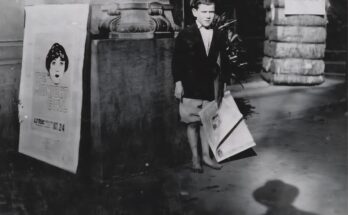In the heart of Evansville, Indiana, in 1930, something extraordinary unfolded—an event that remains one of the most remarkable engineering feats in American history. The Indiana Bell Telephone Company needed to expand, and rather than demolish or rebuild, engineers proposed something radical: rotate the existing 8-story building 90 degrees to make room for a new headquarters. Even more astonishing was the decision to carry out the move without halting business operations inside.
The building, a massive 11,000-ton brick and steel structure, was not emptied for the move. Employees continued their work as usual—typing, talking on the phone, attending meetings—while the entire structure shifted beneath them. Utilities such as water, gas, electricity, and phone lines remained fully operational throughout the process. There was no evacuation, no dramatic interruption—just business as usual, atop a marvel in motion.
The logistics behind the move were as intricate as they were daring. The building was slowly and carefully shifted using hand-operated jacks, a labor-intensive method that required teams of workers pumping steadily. Each pump moved the entire structure just 3/8 of an inch at a time. A steam-powered engine added extra force when needed, but the majority of the motion relied on human muscle and mechanical precision.
The building rested on a bed of rollers that followed a meticulously planned curved track. This path allowed the structure to pivot smoothly into its new position over the course of roughly 30 days. Engineers monitored every inch of the move to ensure the building remained stable, level, and unharmed. Special flexible connections were used to keep utility lines intact, bending and moving as the building slowly crept along its course.
Perhaps the most incredible aspect of the entire project was how seamlessly it all unfolded. Despite the continuous movement, there were no major disruptions inside the building. Phones kept ringing, typewriters clicked away, and employees went about their routines, often unaware of just how extraordinary their workday setting had become.
The building itself suffered no significant structural damage. No walls cracked, no floors buckled, and no glass shattered. The precision and care taken by the engineering team ensured that the building retained its full integrity, even as it shifted 90 degrees to face a new orientation.
When the move was complete, the Indiana Bell building stood proudly in its new position—an 8-story monument to human ingenuity. The successful relocation allowed for the construction of a new headquarters adjacent to it, fulfilling the company’s expansion goals without sacrificing the original structure.
To this day, the Indiana Bell building move remains a powerful symbol of what can be achieved through careful planning, expert engineering, and bold vision. It’s a reminder that even the heaviest challenges—literal or figurative—can be moved with patience, teamwork, and determination.


